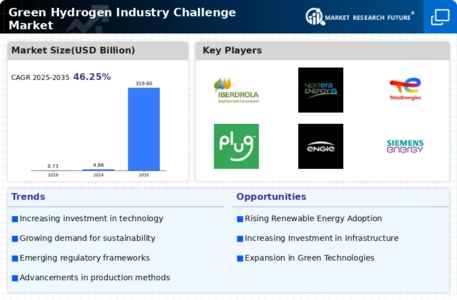Growing Interest from Industrial Sectors
The growing interest from various industrial sectors is a key driver for the Green Hydrogen Industry Challenge Market. Industries such as steel, cement, and chemicals are increasingly exploring hydrogen as a means to decarbonize their processes. For example, the steel industry, which is responsible for a significant portion of global CO2 emissions, is investigating hydrogen-based direct reduction methods. This shift towards hydrogen utilization indicates a broader trend where industries recognize the potential of green hydrogen to meet sustainability targets. As more sectors commit to reducing their carbon footprints, the Green Hydrogen Industry Challenge Market is likely to experience accelerated growth, driven by the demand for innovative solutions that align with environmental goals.
Rising Demand for Clean Energy Solutions
The increasing The Green Hydrogen Industry Challenge. As nations strive to meet their carbon neutrality goals, the demand for hydrogen as a clean fuel alternative is expected to rise. According to recent data, the hydrogen market is projected to reach a value of approximately 200 billion USD by 2030, with green hydrogen playing a pivotal role. This shift is not merely a trend but a necessity, as industries seek to decarbonize their operations. The Green Hydrogen Industry Challenge Market is thus positioned to benefit from this growing demand, as companies and governments invest in hydrogen technologies to reduce greenhouse gas emissions and enhance energy security.
Technological Innovations in Electrolysis
Technological advancements in electrolysis are crucial for the Green Hydrogen Industry Challenge Market. Innovations in this area have led to more efficient and cost-effective methods of producing green hydrogen from renewable energy sources. For instance, improvements in proton exchange membrane (PEM) electrolysis and alkaline electrolysis have shown promise in enhancing production rates and reducing energy consumption. As these technologies mature, the cost of green hydrogen production is expected to decrease, making it more competitive with fossil fuels. This evolution in technology not only supports the growth of the Green Hydrogen Industry Challenge Market but also encourages wider adoption across various sectors, including transportation and industrial applications.
Government Policies and Regulatory Frameworks
Government policies and regulatory frameworks play a pivotal role in shaping the Green Hydrogen Industry Challenge Market. Many governments are implementing supportive policies aimed at promoting hydrogen as a clean energy source. These include subsidies, tax incentives, and funding for research and development. For instance, several countries have established national hydrogen strategies that outline ambitious targets for hydrogen production and usage. Such regulatory support is essential for attracting private investment and fostering innovation within the sector. As these frameworks evolve, they are likely to create a more favorable environment for the Green Hydrogen Industry Challenge Market, encouraging stakeholders to engage in the development and deployment of hydrogen technologies.
Investment in Renewable Energy Infrastructure
Investment in renewable energy infrastructure is a significant driver for the Green Hydrogen Industry Challenge Market. As countries expand their renewable energy capacities, particularly in solar and wind, the potential for green hydrogen production increases. For example, regions with abundant renewable resources can leverage these assets to produce hydrogen at scale. Reports indicate that investments in renewable energy are expected to exceed 1 trillion USD annually by 2030, which will likely bolster the green hydrogen sector. This influx of capital not only enhances production capabilities but also fosters innovation and collaboration within the Green Hydrogen Industry Challenge Market, paving the way for new projects and partnerships.

















Leave a Comment